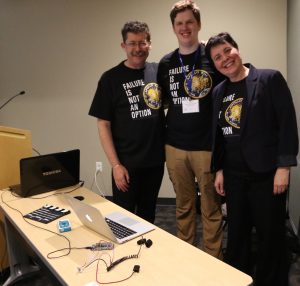At the annual Medbiquitous Conference in Baltimore, OpenLabyrinth provided the underpinnings for a workshop demonstrating the capabilities of the Experience API (xAPI).
 Using a simple Arduino computer, the team of Ellen Meiselman, Corey Albersworth, David Topps and Corey Wirun were able to track the stress levels of workshop participants as they played a very challenging series of OpenLabyrinth mini-cases. Sensors on the Arduino continuously measured heart rate and galvanic skin response which, even on these cheap ($30) kits, were easily sensitive enough to detect subtle changes in stress levels.
Using a simple Arduino computer, the team of Ellen Meiselman, Corey Albersworth, David Topps and Corey Wirun were able to track the stress levels of workshop participants as they played a very challenging series of OpenLabyrinth mini-cases. Sensors on the Arduino continuously measured heart rate and galvanic skin response which, even on these cheap ($30) kits, were easily sensitive enough to detect subtle changes in stress levels.
We intentionally set a very tight set of timers on the case series so that participants were increasingly pushed to make very rapid decisions. The data from the sensors were collected in our GrassBlade LRS, along with xAPI statements from our OpenLabyrinth cases.
Seeing such simple technology providing quite sophisticated tracking of learner stress levels prompted a lot of vigorous discussion in the workshop on how such activity metrics can be used in other ways.
We really appreciate the collaboration and help we received from the xAPI community in pulling this workshop together. We had naively thought that, since both Arduino and xAPI are simple to work with, this would be a nice quick effort. Corey A ran into a lot of tiny but time consuming quirks and put in many hours in getting this all to work smoothly.
We especially want to acknowledge the detailed help we received from Pankaj Agrawal (GrassBlade LRS) and Andrew Downes (Watershed LRS) for their patience and troubleshooting. For some parts of the project, we had some quite sophisticated statement pulls from GrassBlade to Watershed, due to the collaboration of these folks. It really showed us how much more you can achieve by blending the capabilities of these various devices and platforms, using xAPI.

